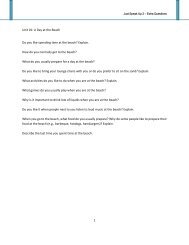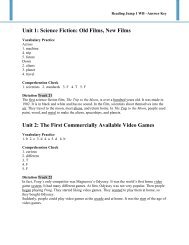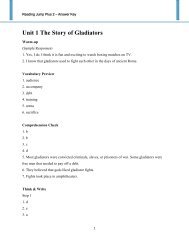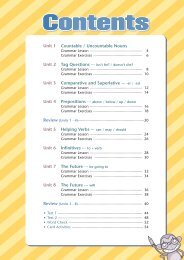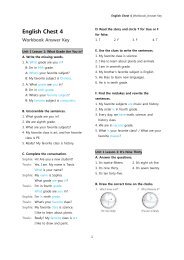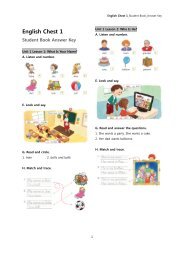Liana Robinson
Liana Robinson
Liana Robinson
Create successful ePaper yourself
Turn your PDF publications into a flip-book with our unique Google optimized e-Paper software.
<strong>Liana</strong> <strong>Robinson</strong><br />
Series Editor<br />
David Paul
ENGLISH CHEST 1 STUDENT BOOK<br />
<strong>Liana</strong> <strong>Robinson</strong><br />
© 2011 Compass Publishing<br />
All rights reserved. No part of this book may be<br />
reproduced, stored in a retrieval system, or transmitted<br />
in any form or by any means, electronic, mechanical,<br />
photocopying, recording, or otherwise, without prior<br />
permission in writing from the publisher.<br />
Series Editor: David Paul<br />
Acquisitions Editor: <strong>Liana</strong> <strong>Robinson</strong><br />
Development Editors: enna Myers, Caroline Murphy<br />
Cover/ nterior Design: Design Plus<br />
email: info@compasspub.com<br />
http://www.compasspub.com<br />
SBN: 978-1-59966-384-5<br />
10 9 8 7 6 5 4 3 2 1<br />
15 14 13 12 11 10<br />
Photo Credits<br />
pp. 6, 7, 8, 12, 15, 18, 21, 24, 27, 30, 32, 33, 34, 38, 44, 46, 47, 50,<br />
56, 59, 60, 64, 66, 70, 76, 78, 82, 84, 85, 86 © Shutterstock, nc.<br />
pp. 6, 8, 15, 18, 30, 38, 46, 47, 50, 56, 58, 61, 64, 66, 68, 76, 78, 82, 86 © iStockphoto nc.<br />
p. 73 © upiterImages Corporation
Syllabus . . . . . . . . . . . . . . . . . . . . . . . . . . . . . . . . . . . . . . . . . . . . . . . . . . . . . . . . . . . . . . . 4<br />
How to Use This Book . . . . . . . . . . . . . . . . . . . . . . . . . . . . . . . . . . . . . . . . . . . . . . 6<br />
Lesson 1 What s Your Name? ................................. 12<br />
Lesson 2 Who s He? .............................................. 18<br />
Lesson 3 Good Morning! ........................................ 24<br />
Lesson 4 What s t? ............................................... 30<br />
Lesson 1 Let’s Count!. ............................................. 38<br />
Lesson 2 What Color s Your Pen?. ........................... 44<br />
Lesson 3 How Old Are You? .................................... 50<br />
Lesson 4 Are You Hungry? ...................................... 56<br />
Lesson 1 He Has Dark Brown Hair. ......................... 64<br />
Lesson 2 Are You OK?. ............................................ 70<br />
Lesson 3 What Shape s t? ..................................... 76<br />
Lesson 4 How Many Toy Cars Are There?. ................. 82
Lesson<br />
Lesson Objective<br />
Grammar Focus<br />
1<br />
Learning the names of the main<br />
characters in the series and the names<br />
of their classmates<br />
• nformation question with what<br />
Unit 1<br />
2<br />
dentifying family members<br />
• Subject pronouns: he, she<br />
• nformation question with who<br />
n the<br />
Neighborhood<br />
3<br />
dentifying the different times of day<br />
(morning, evening, afternoon, night)<br />
• Time of day greetings<br />
4<br />
dentifying a few singular objects<br />
• Singular nouns<br />
• nformation question with what<br />
1<br />
Becoming familiar with some classroom<br />
objects, and practicing counting<br />
• Plural nouns<br />
• nformation question with how many<br />
Unit 2<br />
2<br />
Becoming familiar with more classroom<br />
objects and colors<br />
• Possessive adjectives: your, my<br />
At School<br />
3<br />
Extending students’ knowledge of<br />
plurals and numbers<br />
• nformation question with how old<br />
• Be-verb: is, are<br />
4<br />
Learning how to describe how students<br />
feel (hungry, hot…)<br />
• Be-verb: is, are<br />
1<br />
Becoming more familiar with some<br />
clothing, body parts, and colors<br />
• Possessive adjectives: his, her<br />
• Verb: have (has)<br />
Unit 3<br />
At the<br />
Toy Store<br />
2<br />
3<br />
Becoming more familiar with how to<br />
talk about body parts and talk to a<br />
doctor about things that are wrong<br />
with students<br />
Being able to identify some basic<br />
shapes<br />
• Statements<br />
- hurt my ___.<br />
• Articles: a, an<br />
4<br />
Becoming more familiar with how to<br />
express quantities and practice the<br />
names of some toys<br />
• nformation question with how many<br />
• There is/are ___.<br />
4 Syllabus
Sentence Patterns<br />
Functions<br />
Vocabulary<br />
• Hi! / Hello!<br />
• What’s your name?<br />
- ’m Amy.<br />
- My name is Eric.<br />
• Who is he?<br />
- He’s my dad.<br />
• Greetings<br />
• Names<br />
• Family members<br />
• Asking about people<br />
• dentifying people<br />
doll, ball, train, Katie, Amy, Rachel, Eric,<br />
Max, Jeff, girl, boy<br />
dad, mom, grandma, grandpa, brother,<br />
sister, cake, balloon, present<br />
• Good morning!<br />
• t is day.<br />
• Greetings<br />
• Times of day<br />
morning, afternoon, evening, night,<br />
day, good-bye, sun, moon, clouds, stars<br />
• What is it?<br />
- t’s a kite.<br />
• dentifying objects<br />
• Singular objects<br />
flower, tree, cat, bear, dog, kite,<br />
teddy bear, skateboard<br />
• How many chairs?<br />
• Let’s count!<br />
- OK! One, two... four! Four chairs!<br />
• Cardinal numbers 1-5<br />
• Plural objects<br />
one, two, three, four, five, desk, chair,<br />
door, umbrella, rain, pencil, book, ruler<br />
• What color is your pen?<br />
- t’s black.<br />
- My pen is orange.<br />
• How old are you?<br />
- ’m eight years old.<br />
• How old is he?<br />
- He’s six years old.<br />
• Are you hungry?<br />
- Yes, am. / No, ’m not.<br />
• Classroom objects<br />
• Making comparisons<br />
• Colors<br />
• Cardinal numbers 6-10<br />
• Asking age<br />
• Telling age<br />
• Asking about state of being<br />
• dentifying state of being<br />
rainbow, crayon, pen, backpack, paper,<br />
eraser, notebook, pencil case,<br />
paintbrush, marker, red, orange, yellow,<br />
green, blue, black<br />
six, seven, eight, nine, ten, slide, swing,<br />
see-saw, toy<br />
hot, cold, thirsty, hungry, sleepy, apple,<br />
milk, banana, orange juice, melon<br />
• What color is his hair?<br />
- He has dark brown hair.<br />
• What color are her eyes?<br />
- She has light blue eyes.<br />
• Body parts<br />
• Clothing<br />
• Colors<br />
shirt, socks, pants, shoes, hat, shorts,<br />
eyes, nose, hair, teeth, light, dark, white,<br />
purple, pink, brown, gray<br />
• Are you OK?<br />
- Yes, am.<br />
- No, ’m not. hurt my knee.<br />
• Body parts<br />
• Expressing pain<br />
doctor, nurse, arm, hand, leg, foot, head,<br />
knee, elbow, toe, finger<br />
• What shape is it?<br />
- t’s a circle.<br />
- t’s an oval.<br />
• How many toy cars are there?<br />
- There is one toy car.<br />
- There are four toy airplanes.<br />
• Shapes<br />
• Toys<br />
• Asking the number of objects<br />
• dentifying the number of<br />
objects<br />
teacher, magician, artist, oval, circle,<br />
triangle, heart, square, rectangle, star<br />
bus, boat, skates, house, car, airplane,<br />
puzzle, sticker, puppet<br />
5
Amy is fun and outgoing. She is<br />
a girly-girl who likes to go to the<br />
mall and talk to her friends on the<br />
phone.<br />
Max is energetic and kind.<br />
He likes to listen to music and<br />
skateboard. He also likes to hang<br />
out with his older brother, Cody.<br />
Eric is smart and easy-going.<br />
He enjoys science, photography,<br />
and taekwondo. Some of his<br />
family lives in China!<br />
Katie is friendly and nice.<br />
She likes to sing and dance.<br />
Her parents are from France, and<br />
she speaks French.<br />
Rachel is talkative and athletic.<br />
She likes to go to the park and<br />
spend time outdoors. She also<br />
likes to play the piano.<br />
Jeff is funny and adventurous.<br />
He likes to tell jokes and water-ski.<br />
He also likes to watch scary<br />
movies.<br />
These six children are the main characters of the book. They appear in the Listening Chest. They are all<br />
friends, and they go to the same school. They help teach students the target language and conversational<br />
expressions.<br />
Ms. Monster<br />
appears in various<br />
personalization<br />
activities. She asks<br />
students questions<br />
about themselves.<br />
Mr. Kitty appears<br />
in the Listening Chest.<br />
He helps draw<br />
attention to important<br />
parts in conversations.<br />
These icons appear<br />
before most of the<br />
exercises. They signal<br />
the different types of<br />
activities to students.<br />
These children represent the<br />
students themselves. They<br />
appear in the Language Chest,<br />
and they introduce part of the<br />
target language of each unit.<br />
6 How to Use This Book
The Word Chest<br />
introduces key vocabulary.<br />
Look curiously at the<br />
pictures as if you are<br />
discovering them with the<br />
children. See if the children<br />
can help you by identifying<br />
any of the words, and then<br />
help them discover the<br />
words they do not know.<br />
The students listen to the<br />
audio recording and number<br />
the pictures accordingly.<br />
The recording presents the<br />
words in complete sentences.<br />
The Language Chest<br />
introduces target patterns.<br />
First practice these patterns<br />
orally with the books closed.<br />
Then open the books and<br />
help the students discover<br />
what the children are saying.<br />
The grammar boxes help<br />
both you and the students<br />
identify key grammatical<br />
points. It is important not to<br />
explain or analyze the<br />
grammar. Let the students<br />
acquire it through trial and<br />
error as they work through<br />
the unit.<br />
The Listening Chest<br />
features the main characters.<br />
The target language is<br />
used in a real-life situation.<br />
The children first practice<br />
the dialogue orally with<br />
books closed, then listen to<br />
the dialogue, and finally<br />
open the books and read it.<br />
The target language is<br />
highlighted in blue text.<br />
The follow-up activity is a<br />
comprehension checking<br />
exercise. The format varies<br />
from unit to unit.<br />
7
The Talk Chest presents<br />
the target language<br />
together with the key<br />
vocabulary. The students<br />
look at the picture and talk<br />
about it - such as by<br />
identifying the things and<br />
children in the picture. They<br />
then try to work out what<br />
the children are saying.<br />
The Guide focuses on key<br />
patterns. The children look<br />
at the guide and either use<br />
it to talk about themselves<br />
or pretend they are a puppet<br />
or toy animal and imagine<br />
what the puppet/animal<br />
would say.<br />
The picture prompts focus<br />
on key patterns. The<br />
students first look at the<br />
picture and try to work out<br />
what to say. They then listen<br />
to the audio recording while<br />
looking at the pictures.<br />
The Reading Chest<br />
recycles some of the key<br />
vocabulary and/or target<br />
patterns. The students try<br />
to read the text. They can<br />
also talk or write about<br />
themselves or the world<br />
around them using the<br />
patterns in the text.<br />
The follow-up activity is a<br />
comprehension checking<br />
exercise. The format varies<br />
from unit to unit.<br />
The Writing Chest is a<br />
simple writing activity that<br />
helps consolidate the target<br />
patterns.<br />
8 How to Use This Book
The Activity Chest a<br />
classroom game or board<br />
game. It is a fun way for<br />
the students to practice and<br />
consolidate the patterns<br />
and vocabulary introduced<br />
in the unit. The activities<br />
can be used in a variety of<br />
classrooms and do not<br />
require a lot of preparation.<br />
A personalization activity<br />
accompanies the classroom<br />
games. This gives the<br />
children another opportunity<br />
to express themselves.<br />
The Song Chest is a song<br />
set to a familiar tune.<br />
Ending a unit with a song is<br />
a great way to help students<br />
retain the unit language<br />
targets. We can introduce<br />
the song by playing the<br />
audio recording, getting the<br />
children to read the song<br />
before playing the recording,<br />
or simply by starting to sing<br />
it with the children.<br />
Many of the songs can<br />
be altered to include the<br />
personal information of<br />
the students in the class.<br />
The students can also listen<br />
to the song again at home<br />
or in the car with their<br />
parents.<br />
A special illustration<br />
accompanies each song.<br />
This makes the song more<br />
interesting and memorable<br />
for the students.<br />
9
What s Your Name?<br />
Who s He?<br />
Good Morning!<br />
What s t?
Track 1<br />
A. Listen and number.<br />
Katie Eric 1 Amy<br />
doll train ball<br />
B. Ask and answer.<br />
1. What’s your name? 2.<br />
What’s your name?<br />
’m enny.<br />
My name is Tom.<br />
What’s = What is<br />
’m = am<br />
12 Unit 1 Lesson 1
Track 2<br />
C. Talk, listen, and read.<br />
Look!<br />
Hi, what’s your name?<br />
’m Amy.<br />
My name is Eric.<br />
My name is Katie.<br />
D. Trace and write your name.<br />
1. 2. 3.<br />
name is<br />
is<br />
Amy.<br />
Katie.<br />
.<br />
13
E. Look and say.<br />
What’s your name?<br />
_____ ___________ is Holly.<br />
_____ am Ben.<br />
What’s your name?<br />
My name is _________________. / am ( ’m) _________________.<br />
F. Picture prompts.<br />
Track 3<br />
1. 2.<br />
Max / Eric<br />
3.<br />
eff / Amy<br />
14 Unit 1 Lesson 1<br />
Katie / Rachel
Track 4<br />
G. Read and circle.<br />
Toot! Toot!<br />
My name is Tony.<br />
’m a train.<br />
have toys!<br />
have dolls!<br />
have balls!<br />
Toot! Toot! Dolls!<br />
Toot! Toot! Balls!<br />
1. Tony is a (train / doll).<br />
2. The train has (dolls and balls / girls and boys).<br />
H. Match and trace.<br />
1.<br />
2.<br />
3.<br />
15
. Play. Toss the ball.<br />
What’s your name?<br />
My name is Amy.<br />
Good!<br />
What’s your name?<br />
’m Eric.<br />
. Answer and draw yourself.<br />
What’s your name?<br />
.<br />
K. What are your classmates’ names?<br />
16 Unit 1 Lesson 1
Track 5<br />
L. Listen and sing along.<br />
The Hello Song<br />
Hi! Hi! Hi! Hello! Hello!<br />
What’s your name?<br />
My name is Max.<br />
What’s your name?<br />
My name is Ann.<br />
Hi! Hi! Hi! Hello! Hello!<br />
17


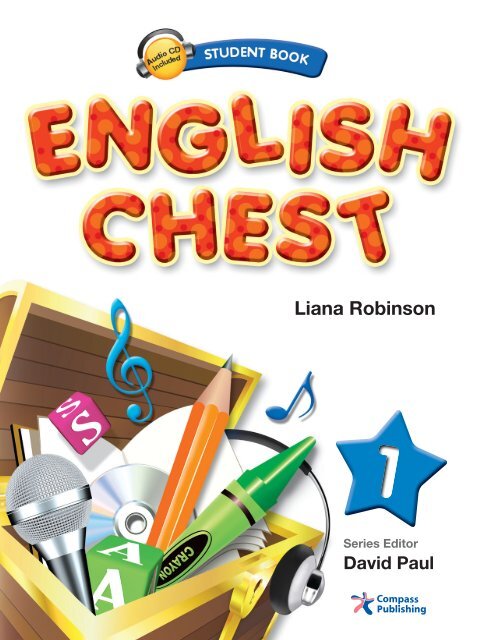
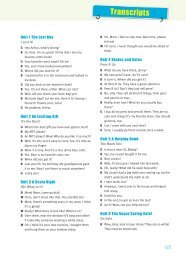
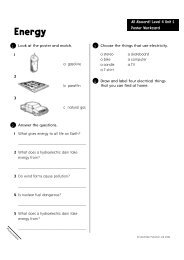
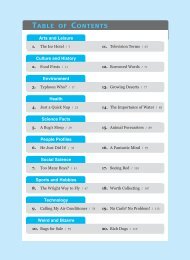
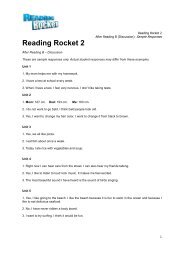
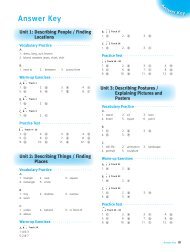
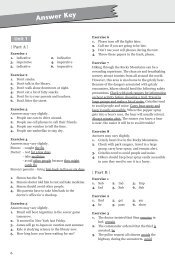
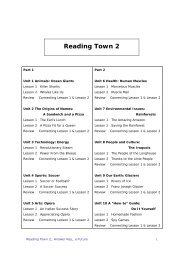
![Unit 1 [ Double Letters bl, cl, fl ] Unit 2 [ Double Letters br, cr, fr ] Unit ...](https://img.yumpu.com/50474659/1/190x242/unit-1-double-letters-bl-cl-fl-unit-2-double-letters-br-cr-fr-unit-.jpg?quality=85)
